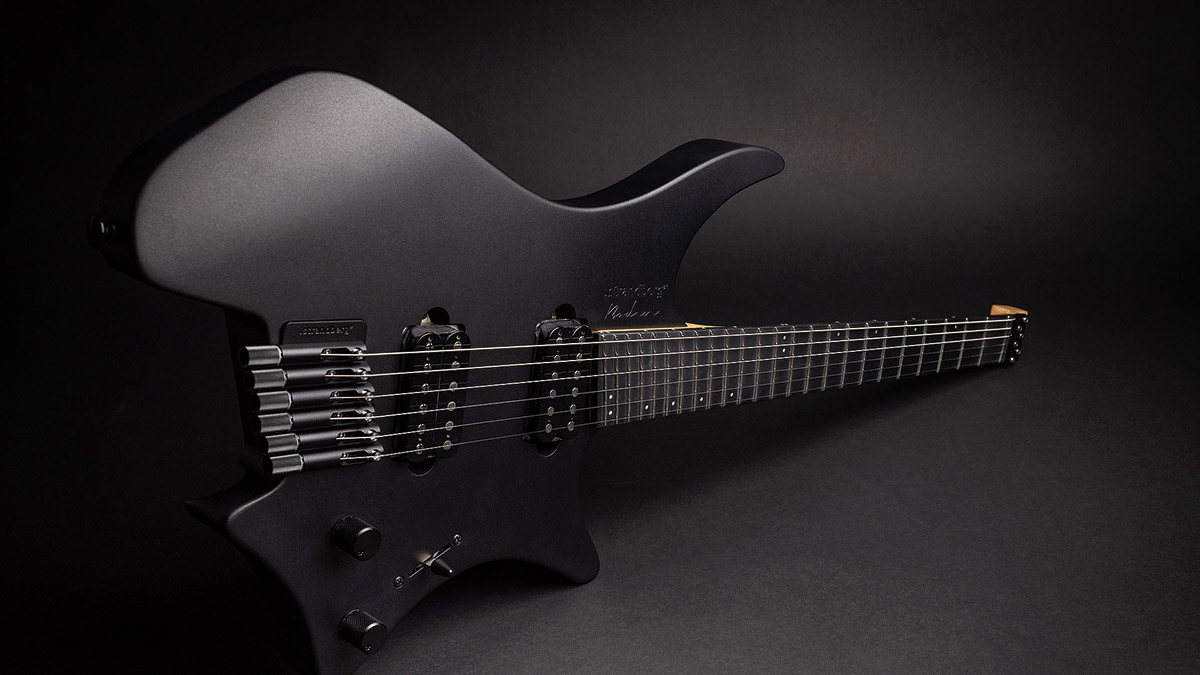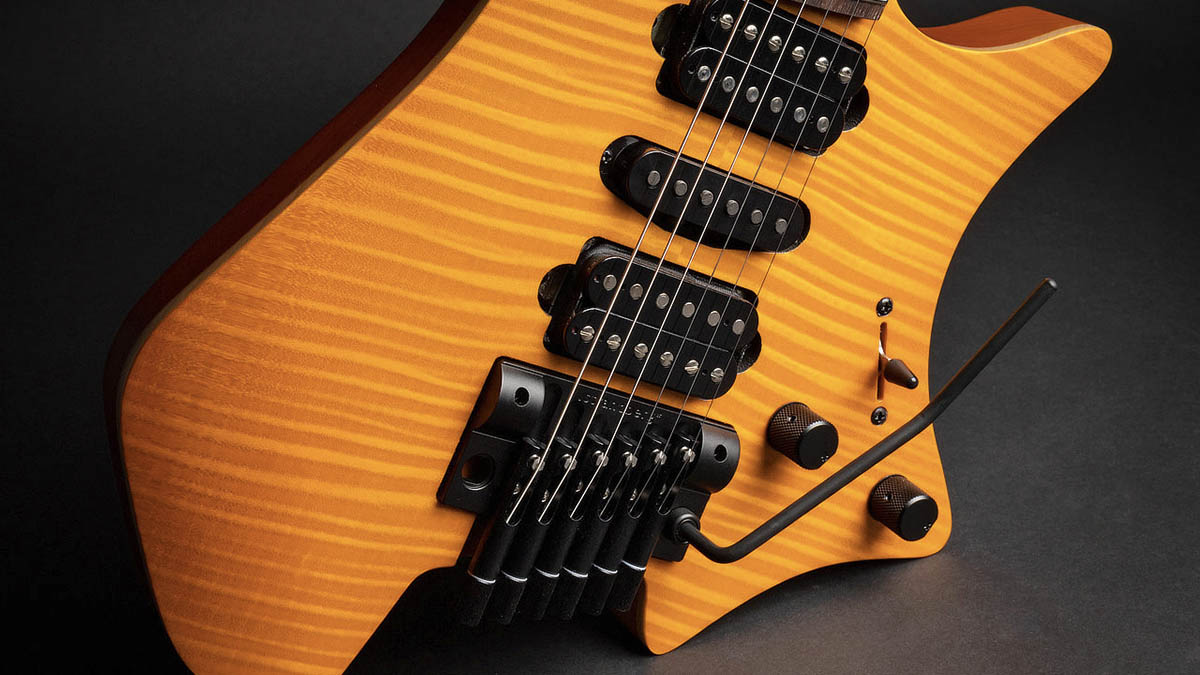How Ola Strandberg redefined electric guitar ergonomics for a new generation
The guitars built by .strandberg may look unconventional, but they’re designed to be more ergonomic and playable than guitars of the past, says founder Ola Strandberg

For many people, Sweden is the home of thoughtful, elegant design. From vintage Saab cars to furniture from flatpack-icon IKEA, the signature style of Swedish manufacturing is a purposeful minimalism where sleek looks combine with high-level functionality. And so it proves with .strandberg guitars, too.
Based in the city of Uppsala, near Stockholm, the company is the brainchild of Ola Strandberg, who was kind enough to join us for a chat about the guitars he’s been building and refining since the early '80s.
Why did you adopt a non-traditional, headless design for .strandberg guitars?
“It started as a hobby. I built guitars in my teens and had not looked at a guitar for almost 15 years. I was kind of shocked after those 15 years when I decided to make myself another guitar, and went to my favourite music store and, looking around, nothing had happened. That was kind of a shock… the Tube Screamer was still the favourite overdrive pedal, which I had used years before.”

“So I guess that was like the first seed of, ‘let’s make something different’, but then I kind of slipped into it because I was attracted to the headless concept. I had owned a Hohner Steinberger copy back in the day, which I had butchered. I built a new body and neck for it, but I reused the original hardware. I was attracted to that concept, so when I started planning my own guitar I wanted to make it headless and I just realised that there was no headless hardware to buy anywhere.
Even people who wrap their thumb around the top of the neck, they still find that it works really well
“Then I stumbled on this community called Building the Ergonomic Guitar, which was an online community of a few guitar builders. They were trying to do something different and solve a problem, not just build a guitar. I was attracted to that as well, so that kind of became the project: not just build a guitar for myself but to solve this problem of guitar ergonomics and in such a way that I would want to be a customer [for what I was building].”

“I also had a long background in the software industry and product development and management overall. So that made me think up this product concept, which I named the Ergonomic Guitar System, which featured [tiered] levels of ergonomics.
All the latest guitar news, interviews, lessons, reviews, deals and more, direct to your inbox!
“First, I would make hardware that would allow you to convert your existing hardware to make it lighter and more ergonomic. The second level of the Ergonomic Guitar System was a replacement neck that you could fit to replace the neck of your existing guitar. Then level three of the Ergonomic Guitar System was the entire guitar – the guitar body shape that I had come up with.
“I don’t think the decision was necessarily to make something untraditional. The decision was more one of ‘approach this as an industrial design project and come up with a compelling offering for ergonomics’. It started there.”

Tell us about the neck profile. It’s a really remarkable shape…
“Yes, the original idea was inspired by a bass builder called Jerome Little, who designed what he called the Torzal Twist neck, where the neck is actually twisted, so as you extend your arm you can straighten your wrist. That seemed to make a lot of sense, but at the same time it’s a very complicated construction – it’s very hard to manufacture.
“Lace Music Products, who make the Lace Sensor Pickups, actually had a commercially available guitar with this twisted neck. I had the opportunity to visit them in California and talk to them. They showed me this neck and it was obvious it worked in terms of ergonomics.
“At the same time, you’d have to adapt your playing technique because you can’t bend upwards. If you bend upwards you’ll choke the strings, so you can only bend downwards. That would be a huge limitation. The other limitation is if you need to service your guitar and bring it to a guitar tech, I’m pretty sure 100 per cent of guitar techs would just say, ‘No, I’m not going to touch that…’
“So I wanted to accomplish the same function but with more standard production techniques, something that would be more user-friendly and wouldn’t require you to change your playing style. That was the first objective.
“The second was very early on I did some collaborative work with Rick Toone, who is an American guitar builder. He had come up with this trapezoidal neck shape, with three flat surfaces on the rear. I noticed that kind of neck shape was just more comfortable to play; there was less fatigue in the hand when playing.
What I find from people who try our neck design is that it seems weird for a few minutes but then quickly becomes second nature
“Later, I combined those two concepts with the angular surfaces – but I would just twist the surfaces, so I twisted the rear of the neck but not the front of the neck. I discovered that worked just as well as the original Torzal Twist innovation because the angles in both surfaces would encourage you to play with a straighter wrist angle.
“Combining that with the three distinct surfaces [on the rear of the neck], rather than the semicircle, gave those benefits as well, so it both relaxes muscles and tendons in your fretting hand and forearm but also encourages this straighter wrist angle.”
How do players take to it, in your experience? It’s quite different from a traditional neck shape.
“In general, what I find from people who try our neck design is that it seems weird for a few minutes but then quickly becomes second nature and doesn’t feel strange any more.
“I guess there’s also a third aspect of it, which is the cross section of the neck, so what you would refer to as thickness, is actually thicker than a lot of necks. That also comes from ergonomics: if you want to grip a very thin object you have to press hard and it creates fatigue in the hand. If you grip something that’s thicker, it’s easier to grip.”

“With the way the three surfaces interact and the angles, you don’t necessarily think of it as, ‘What a chunky neck.’ It kind of tricks your brain into experiencing it as a thin neck. That contributes a better tone because there’s more mass in the neck, but it also has these ergonomic benefits.
“I think generally, if people want a comfortable neck on a fast-playing guitar, they think of a super-thin Ibanez Wizard-type neck. So a lot of people who are looking for good ergonomics will contact us and say, ‘How thick is the neck? I like thin necks.’
“We then say we prefer not to talk about dimensions because that dimension won’t mean anything to you – we say instead, ‘Just try it and see if you like it.’ Generally, people find that it works really well. That’s regardless of playing style – even people who wrap their thumb around the top of the neck, they still find that it works really well.”
How do you feel when you see professional musicians making the switch to your guitars?
“That is the ultimate reward, I think. To see the instruments in use, hear music that’s created by them, hear the stories of people who become more inspired by a .strandberg guitar and they look at it and want to pick it up and they start playing more, whether they had ergonomic problems or not.
Right now we know that most .strandberg customers didn’t buy a .strandberg guitar because of ergonomics. They got it because they felt it was a better-performing instrument
“Right now we know that most .strandberg customers didn’t buy a .strandberg guitar because of ergonomics. They got it because they felt it was a better-performing instrument.
“I also think we’re going to more of a digital environment [as guitarists] and being like a desktop musician using a lot of headphones and near-field monitors. In that environment, you hear the difference in a .strandberg guitar much more than you would have a bunch of years ago when you went to some rehearsal space and you had a stack of amplifiers behind you.
“So I think the environment where you create music has gone hand in hand with this. I mean, now, just the resolution of the audio chain highlights the defects of 1950s technology. So I think it raises the bar of what an instrument needs to do, and we’ve been able to meet that better than a traditional design.”
- For more information, head to strandbergguitars.com.
Jamie Dickson is Editor-in-Chief of Guitarist magazine, Britain's best-selling and longest-running monthly for guitar players. He started his career at the Daily Telegraph in London, where his first assignment was interviewing blue-eyed soul legend Robert Palmer, going on to become a full-time author on music, writing for benchmark references such as 1001 Albums You Must Hear Before You Die and Dorling Kindersley's How To Play Guitar Step By Step. He joined Guitarist in 2011 and since then it has been his privilege to interview everyone from B.B. King to St. Vincent for Guitarist's readers, while sharing insights into scores of historic guitars, from Rory Gallagher's '61 Strat to the first Martin D-28 ever made.

